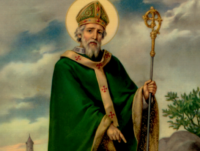St. Patrick
St. Patrick is one of Christianity’s most widely known figures. Personally, I know his story best from Veggie Tales. However, many of the stories associated with St. Patrick, including his banishing all the snakes from Ireland, are false.

St. Patrick was born in Britain to a wealthy family near the end of the fourth century. He is believed to have died on March 17, now St. Patrick’s Day, around 460 A.D.
At 16, Patrick was taken prisoner by a group of pirate raiders as they attacked his family’s estate. They took him to Ireland, where he spent six years in captivity. During this time, he worked as a shepherd. Alone and scared, he turned to his religion for comfort, becoming a devout Christian.
After more than six years as a prisoner, Patrick escaped. According to his own account, the voice of God spoke to him in a dream, saying it was time to leave Ireland.
Patrick walked nearly 200 miles to the Irish coast. When he arrived in Britain, Patrick reportedly experienced a second revelation. An angel in his dream told him to go back to Ireland but this time as a missionary. Patrick began a religious study that lasted more than 15 years.
He was ordained and then went to Ireland to minister to Christians and to begin to convert the nonbelievers. There were some Christians when Patrick arrived; however, most Irish people of the time practiced a nature-based pagan religion. The Irish culture centered on oral legend and myth.
Familiar with the Irish culture, Patrick chose to incorporate familiar rituals into his lessons of Christianity rather than eradicate native beliefs. For example, he used bonfires to celebrate Easter because the Irish honored their gods with fire.
Near the end of his life, he retired to Saul, where he wrote a short autobiography, Confessio. According to his writing, an angel revealed to him that he would die at Saul, the site of his first church.






